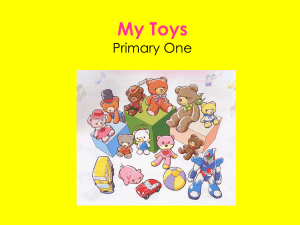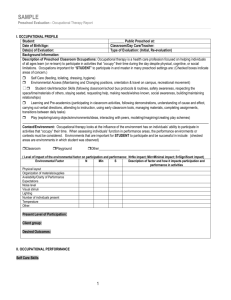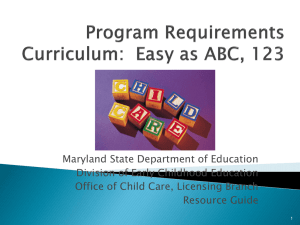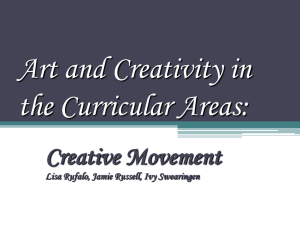Presentation
advertisement
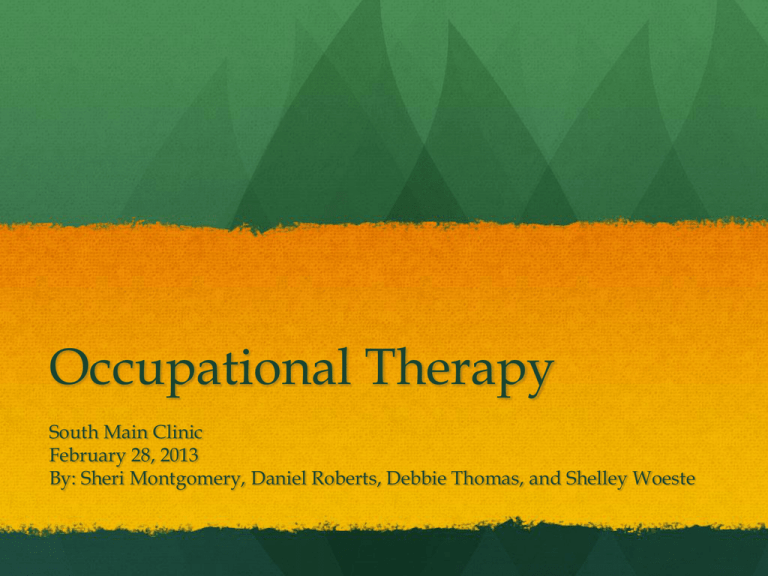
Occupational Therapy South Main Clinic February 28, 2013 By: Sheri Montgomery, Daniel Roberts, Debbie Thomas, and Shelley Woeste Occupational Therapy promotes function and engagement in daily habits and routines. The “occupation” of life skills. Areas of Occupation • Activities of Daily Living • Fine and Gross Motor Skills • Rest and Sleep • Work • Play and Leisure • Social Participation • Education Activities of Daily Living Dressing Grooming; combing hair, brushing teeth Bathing Doing Laundry Cooking Managing Money Being safe in all environments Meal time help with feeding and foods Fine and Gross Motor Skills • Interacting and manipulating objects • Coloring and writing • Visual motor and visual perception tasks like puzzles, mazes and game • Fastening zippers, buttons, and snaps • Moving from the floor to standing • Running, jumping, hopping, playing on the playground Work and Play/Leisure Help with finding appropriate employment Offer suggestions to modify the task or environment for success Assist with training to learn the skills needed Develop social skills for the job Learn about money management Help with interaction and manipulation of toys and objects Improve turn taking skills Help to develop social skills Improve motor skills Develop problem solving skills and abilities Create interest in tasks and activities Social Participation Manage Emotions Develop self-advocacy skills Strengthen family bonds Create routines and schedules Develop social skills Occupational Therapy • Direct services • Service Coordination • Referrals to others • Consultation • Family Education and Training • Offer positioning ideas • Ensure safety • Promote sensory rich experiences How Can Occupational Therapy Help? Occupational Therapists team with families to care for children and promote growth and development in natural environments where families live, work, and play. Occupational Therapists respect the unique interests, cultural, needs and priorities of the child and family and build on their strengths and abilities Occupational Therapists support children and families to be successful in their everyday routines. Occupational Therapists modify activities or the environment so that individuals can participate independently or with others. Occupational Therapists work closely with the families to identify their needs. What Can Parents and Families Do Encourage sensory rich play by using balls, sand and water toys, slides, swings, finger paints and magnets. During sensory play, children use their senses to as they explore, discover, examine, and organize their activities. Promote imaginative or pretend play with things like dolls and stuffed animals, toy furniture, puppets and telephones. Pretend play encourages creativity and role playing and provides an opportunity to rehearse social skills. Encourage manipulative play, such as using play dough, playing cards, stacking blocks or boxes, putting coins into a piggy bank, LEGOS, and board games. Toys such as puzzles, pegboards, beads, lacing cards, and hand writing to help improve the child’s eye-hand coordination and dexterity. Choose toys that are appropriate to the child’s age and/or maturity level. Common objects, such as pots and pans, empty boxes, spools of thread, shoelaces, and wooden spoons are readily accessible and encourage children to use their imagination. Encourage children to participate in sports and games that could improve visual, motor, and coordination skills, such as playing ball, jacks, marbles, and outdoor sports. Recommended Toys and Activities INFANTS Rattles, mobiles, playmats, mirrors, crib toys, infant swings, teething toys, busy boxes and squeeze toys TODDLERS AND PRESCHOOLERS Blocks, stacking rings, pegboards, shape sorters, push and pull toys, balls, books, sand and water toys, large beads, movement games, toy cars and trucks, train sets, dolls, and musical toys SCHOOL-AGED CHILDREN Building sets, books, playground activities, bicycles, board games, crafts, performing art experiences-musical instruments, plays, and beginning sports MIDDLE SCHOOLERS AND ADOLESCENTS Athletics, books, performing arts, after school activities, clubs, hobbies, crafts, and limited screen time Community and Home Promote safe environments Promote safe transportation Increase ease in transitions Facilitate participation in community activities Support social opportunities within the community Establish healthy sleep and nap schedules Design safe play and work areas Support family caretaking abilities Assist with routine regarding homework




